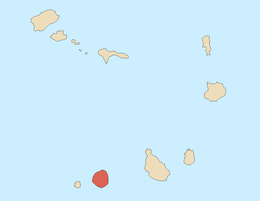Monte Velha
| Monte Velha | |
|---|---|
 View of Chã das Caldeiras from the slopes of Monte Velha | |
| Highest point | |
| Elevation | 1,482 m (4,862 ft) |
| Listing | List of mountains in Cape Verde |
| Coordinates | 15°0′08″N 24°20′42″W / 15.00222°N 24.34500°WCoordinates: 15°0′08″N 24°20′42″W / 15.00222°N 24.34500°W |
| Geography | |
 Monte Velha southeastern Boa Vista | |
| Geology | |
| Mountain type | Stratovolcano (extinct) |
| Last eruption | unknown |
| Climbing | |
| First ascent | unknown |
| Easiest route | road and hiking |
Monte Velha (Portuguese meaning the old mountain) is a mountain in the northeastern part of the island of Fogo in Cape Verde. At 1,482 m elevation, it is the island's third highest point.[1] It is located between Chã das Caldeiras north of the northern part and is inslde the municipality of Mosteiros, other places within the mountain include Feijoal. It has one of the most important forest reserves in the country.[2] It has path accessible to the hikers connecting the caldeira and the Atlantic.
Up above, it has panoramic views of much of the northeast of Fogo and the western part of the island of Santiago, Maio can almost cannot be seen.
Geography
Topography
Its topography compares to the volcano of Pico do Fogo, Monte Velha characterizes by steep slopes dominating about 30% of the area between the summit and the sea.[3]
Climate
Due to the exposure of northeast winds, Monte Velha is being the most humid part of the island, it features different vegetation.[4] It has a precipitation season located at the altitude of 1,300 meters,[5] it observes monthly rainfalls and reval important differences. For an example, the yearly precipitation between 1970 and 1988 measured in Feijoal and Mosteiros, at an altitude of 285 m and by the coast, 322.4 millimeters was measured in Patim located on a semi-arid part of the south coast at the elevation of 535 meters, received only 162.6[6] However, the Portuguese geographer Orlando Ribeiro studied the volcano area in the 1950s just before the 1951 eruption.,[7] rainfall amount measured at 1,037 mm on the mountain compared to 509 mm at Feijoal.[8] A German thesis compared the irregularities in 2000 with 383.6 mm in 1998, 1,480 in 1999 and 1,457 in 2000.[9]
Environmental protection
Trees includes eucalyptus, pines, mimosas, lemon and cypresses, it is protected as part of Monte Velha Forest Permieter (Perímetro florestal de Monte Velha) which covers 850 hectares of land located at an altitude of 1,000 meters and includes the summit.
The nature reserve was suffered by a few forest fires.[10] In 2004, 300 hectares was destroyed, a third of the area. On April 23, another forest fire but smaller destroyed 80 hectares, about 6% of the forest perimeter, it affected the area rich in endemic plants including Euphorbia tuckeyana, lantisk (lantisco) (Periploca chevalieri), losna (Artemisia gorgonum), erva-cidreira (Satureja forbesii), cravo-bravo (Erysimum caboverdeanum).[11] With the help of rainfall, reforestation campation started in early August 2011.[12]
History
The mountain was larger and less slopy until the gigantic eruption of 73,000 BC that sunk the northeast part into the ocean.
See also
References
- ↑ Lesourd, Michel (2006). Le Cap-Vert. Paris: Jaguar. p. 129. ISBN 978-2-86950-408-0.
- ↑ Áreas protegidas, Cabo Verde (Portuguese)
- ↑ Requedaz, Delucchi, p. 144
- ↑ Sorgial, p. 88
- ↑ "SIEREM (Système d'informations environnementales sur les ressources en eau et leur modélisation)" (in French).
- ↑ Lesourd (1996) p. 93
- ↑ A Ilha de Fogo e as Suas Erupções (The Island of Fogo and its Eruptions), Lisbon, 1954
- ↑ Barbe, p. 108
- ↑ Leyens, p. 8
- ↑ "Fogo: Incêndio consumiu mais de 80 hectares do perímetro florestal de Monte Velha" [FIre Consumed About 80 Hectares of the Monte Velha Forest Perimeter]. SAPO CV (in Portuguese). 28 April 2011.
- ↑ "Incêndio devasta área de 50 hectares na zona florestal de Monte Velha, no Fogo" [Fire Devastated an Area of 50 Hectares in the Forest Area of Monte Velha in Fogo] (in Portuguese). RTC.
- ↑ "Fogo: campanha de reflorestação arranca em Monte Velha para recuperação da área consumida pelo incêndio". Expresso das Ilhas (in Portuguese). 9 August 2011.
Further reading
- André Barbe, Les îles du Cap-Vert, de la découverte à nos jours, une introduction : de l'entrepôt des esclaves à la nation créole, L'Harmattan, Paris, 2003 ISBN 2-7475-3730-7
- Michel Lesourd, État et société aux îles du Cap-Vert : alternatives pour un petit État insulaire (State and Society of the Cape Verde Islands), Karthala, Paris, 1996 ISBN 2-86537-625-7
- Michel Lesourd Le Cap-Vert, Jaguar, Paris, 2006, p. 129 ISBN 978-2-86950-408-0
- Teresa Leyens, Biodiversität und Erhalt der Hochlagenvegetation der Insel Fogo (Kap Verde): Ausarbeitung eines Konzeptes für ein Schutzgebiet, University of Bonn, 2002, p. 8 (pdf)
- Sabrina Requedaz, Laurent Delucchi, Cap-Vert,, Olizane, Geneva, 2011 (6th ed.) ISBN 978-2-88086-394-4
- Pierre Sorgial, Guide des îles du Cap-Ver', Karthala, Paris, 1995 (2nd ed.) ISBN 2-86537-596-X
External links
| Wikimedia Commons has media related to Monte Velha. |
